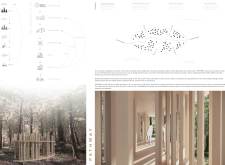5 key facts about this project
The PATHWAY pavilion is characterized by its integration with the surrounding forest environment. It features a meandering pathway that invites engagement and exploration, allowing visitors to traverse both the interior space and the adjacent natural landscape. The primary structural elements are made from engineered timber products, including glued laminated timber (glulam) for columns, which provide vertical support and create a rhythmic spatial experience. This approach merges functionality with aesthetic coherence, as the timber elements emphasize a connection to nature.
The design represents a commitment to sustainable architecture, with careful consideration of materiality and environmental impact. The use of timber not only offers structural advantages but also aligns with ecologically sound practices. It stands as a model for how architecture can incorporate renewable materials, highlighting the importance of sourcing timber responsibly.
Unique Design Approaches
The PATHWAY pavilion distinguishes itself through its focus on modular construction, allowing for easy disassembly and potential relocation. This flexibility underlines a forward-thinking approach to design where the lifecycle of the building is considered from the outset. The integration of cross-laminated timber (CLT) in parts of the pavilion further supports this innovative methodology, demonstrating the benefits of modern timber construction in terms of sustainability and efficiency.
Key architectural features include large glass openings that foster connectivity with the surrounding environment. These elements facilitate natural light penetration while offering framed views of the forest, enhancing the visitor experience while promoting awareness of the natural setting. In doing so, the pavilion serves not only as an architectural feat but also as an informational resource, equipped with panels that educate visitors on timber usage and ecological impacts.
Engagement with Nature
The overall design promotes a dual engagement with the natural surroundings. Internally, the warmth of the timber and the carefully curated spatial layout create an immersive experience for visitors. Externally, the pavilion frames views of the forest, encouraging reflection on topics pertinent to forest health and climate change.
To gain deeper insights into the PATHWAY project, viewers are encouraged to explore architectural plans, architectural sections, and architectural designs that elaborate on the material specifications and construction techniques employed. This comprehensive examination of architectural ideas will provide a clearer understanding of the project's significance in contemporary architecture.























